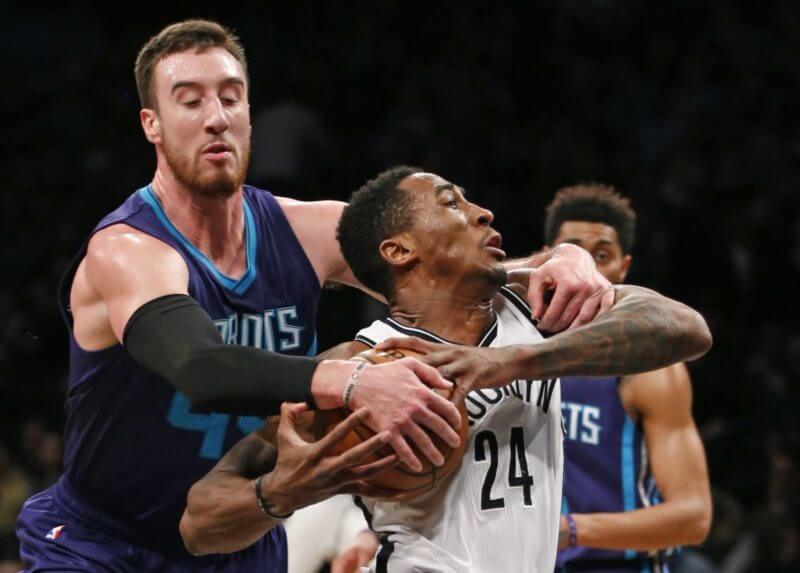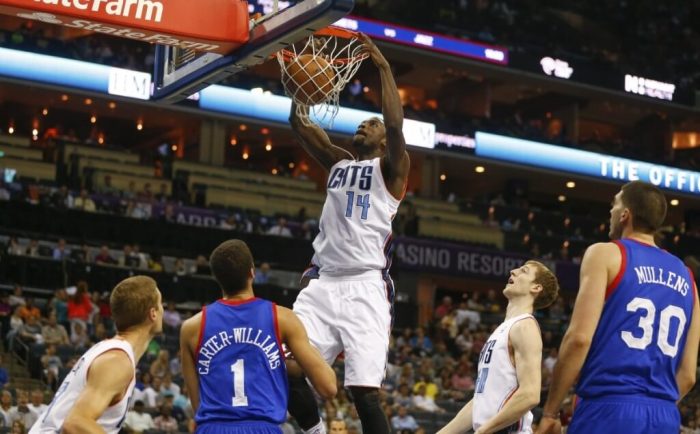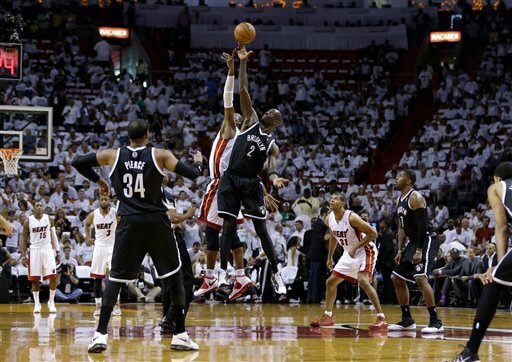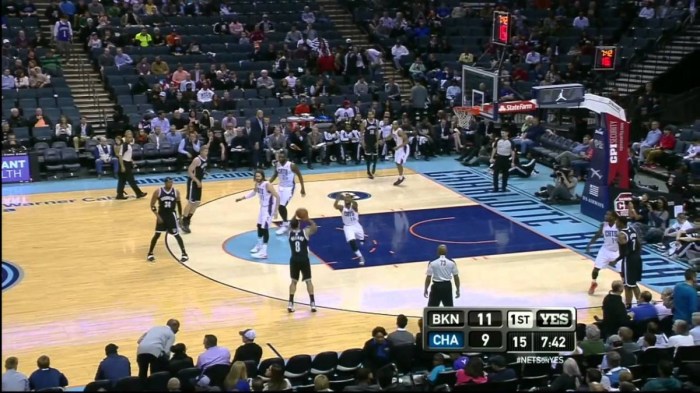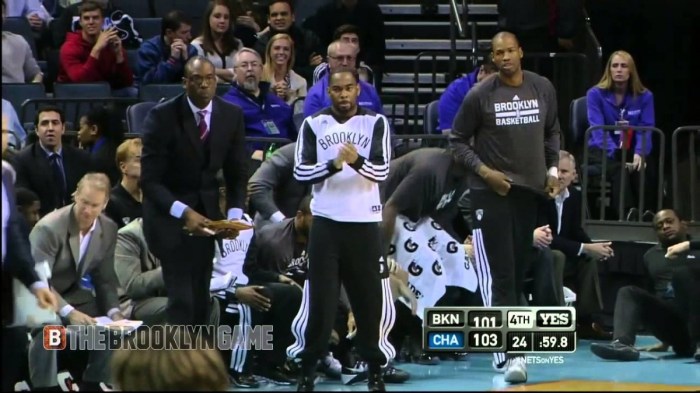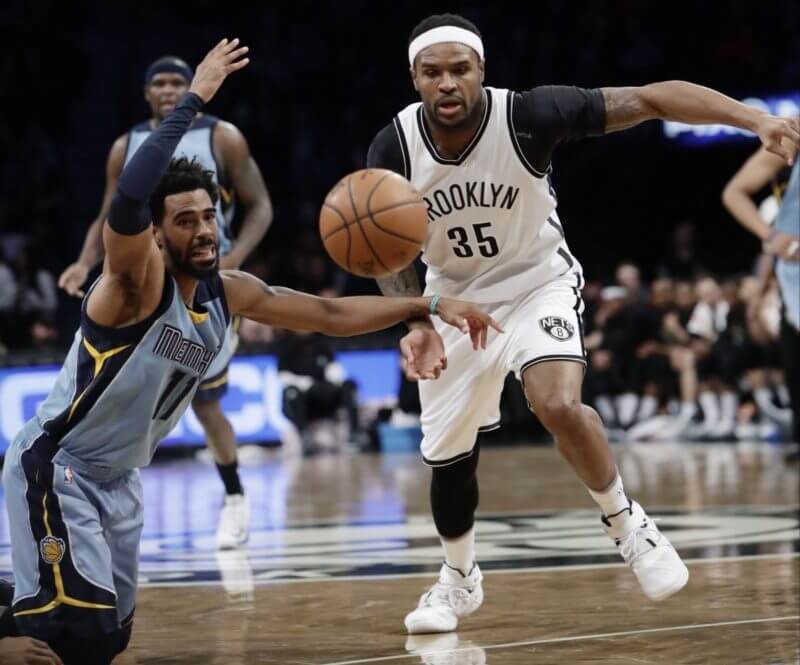
Sustainably Sourced: Adding the Ingredients for an Efficient Nets Offense, Part II
Rebuilding an NBA franchise is a painful process that every NBA team — aside from the San Antonio Spurs — must undergo. Without their own draft picks, the Brooklyn Nets must look everywhere to find players that fit Sean Marks’ envisioned program and the system that coach Kenny Atkinson aims to run. Earlier, I mentioned that point guard play, attacking, and off-ball movement are three skills that Marks should look for in optimizing the Nets’ future offense. Those are just a few of the sustainable skills that could have the Nets striking gold in free agency and the draft.
Ideally, the Nets’ ideal offensive player can shoot, attack off the dribble, pass, and play off-ball well. Unfortunately, James Harden is locked up for the near future and Michael Jordan is turning 54 in a few weeks. I texted the other perfect Kenny Atkinson fit a simple “you up?” last night, but they haven’t responded, unfortunately. Like a good burrito, the Nets have to build their team with complementary components. In a system that requires cooperation and cohesion team-wide, each player needs to be multi-faceted. The future Nets most likely will not be superstar driven, so for the offense to run smoothly, they need more than just strong individual play.
The Art of the Screen
In my last post, I elaborated on the underrated skill of off-ball movement and its value in Atkinson’s offense. I mentioned how a player without the ball should come off of a screen quickly, always looking ready for a pass. But for the screen and cut, screen and roll, or pick and pop, it takes two to tango. Setting the screen, pick, or human traffic cone is a part of the Nets’ offense that has been missing — as, of course, a strong screen seals the defender or creates a mismatch.
In Atlanta, Paul Millsap and Al Horford were the key screeners for all of the Hawks’ perimeter action. Kyle Korver’s shooting in 2014-2015 was set up by his effort to sprint off of the screens of Horford and Millsap.
https://gfycat.com/GregariousActiveGemsbuck
Even the Hawks’ bench bigs, Mike Scott and Tiago Splitters are skilled screeners — and a good screen can be as effective as a perfectly-placed pass:
https://gfycat.com/BouncyPaleJackal
In the below plays, we’ll see a smattering of Nets’ offensive opportunities — sure, they don’t have the personal of the Hawks, but you can see how Brooklyn is looking to implement a pitch-perfect remix of it.
http://streamable.com/3jfrl
In those plays, Quincy Acy, Rondae Hollis-Jefferson, and Trevor Booker set strong screens, trapping the smaller defender — although the results are still mixed, which is something the Nets will need to get stronger at. While Randy Foye finishes his pull-up past the screen, Caris LeVert promptly throws his pass into the front row — the Hawks, more often than not, execute and put two points on the board here.
The final cut sees Booker unable to set a strong screen initially, but he fights and sets a better one that frees up Spencer Dinwiddie for the mid-range jump shot.
http://streamable.com/ovro6
Next, Luis Scola sets a high screen, which frees Isaiah Whitehead for a lane to the basket. While his age has been evident this season, especially on a team that plays so quickly, Scola is still the best screener on the Nets.
http://streamable.com/5zute
Here, Scola slips the screen, making just enough contact to allow Whitehead to turn the corner and attack — also getting his hip out to slow Kay Felder down. He may not be part of the Nets’ future on-court, but Scola’s screen-setting skill and his ability to vary his screens are the little things that make a difference in games.
I may have a crush on Scola’s fine-wine game, but I’d like to see him remain with Brooklyn in the Mike Miller/Nick Collison/Metta World Peace role to keep the young guys motivated — his knowledge of basketball minutiae and smarts could be passed down to the young Nets.
http://streamable.com/3sixg
In just this one possession, we see prime examples of poor screens. Brook Lopez comes up to set the screen for Dinwiddie, but he fails to set his feet and establish position. This is an issue because establishing a firm position is a guide for the ballhandler. He tries a second time, but again, he fails to use his size to slow down Kemba Walker.
Now, this doesn’t mean Lopez can’t set a hard screen, but the entire possession breaks down and the Nets rarely score without a strong foundation to start the motion. Lopez sets a great screen below, which leads to a nice midrange shot for Foye:
http://streamable.com/mvfc4
The two centers, Lopez and Justin Hamilton, have shown willingness to set strong screens. However, most of their screens consist of just running up to the ballhandler and standing in the vicinity of the defender.
http://streamable.com/1qcy6
The double stagger screen is a key action at the beginning of Nets’ offensive sets. Against the San Antonio Spurs, the Nets ran those sets frequently — however, the screens set were lackluster. Above, you can see Dinwiddie and Booker give Dejounte Murray love taps as Bojan Bogdanovic cuts to the top of the key.
Solid screens on that initial action could give the cutter an open look at the top of the three-point line and, yet, it’s often lacking for an inexperienced Nets team.
In scouting potential players, or in developing their own personnel, setting a proper screen is a useful offensive tool. Becoming a strong screener is more about effort than pure basketball skill. The art of the screen can be taught and developed much quicker than shooting or defense. Screening is not a complicated skill, but it is too often overlooked and missed this season.
Quick Decision-Making
It’s the fourth quarter in a close game — just for a second, pretend that it’s not the Nets in this game. The offensive player gets into the lane, slows down while keeping his dribble alive, and looks around the floor before making a decision. The offensive player’s man has caught up and is able to get a hand up in his face and the off-ball defenders have positioned themselves to deny a pass. The possession ends in a forced shot with the shot clock winding down — it ends empty-handed.
Now, if the player was able to make his move and make a decision quicker, he could have scored, drawn a foul, or dished to an open man — that’s where the speed of decision-making comes in.
Nets players have been able to attack in the lane, but often stop halfway or hesitate before making a move. That could be due to many of the players still adjusting to the offense. Yes, it has been over half a season, but it’s difficult to establish a rhythm and continuity with a lineup constantly in flux.
Below, Dinwiddie gets under the basket on a nice drive against Minnesota…
http://streamable.com/dwzeb
He dribbles around half court in a U, moving aimlessly before passing it off to Acy. On a drive where defenders are drawn in, Dinwiddie could have passed it off with defenders surrounding him under the basket or attacked the rim himself.
http://streamable.com/3vtj3
This may be minor, but on a mismatch against the slower Shabazz Muhammad, Whitehead receives the ball from Lopez and really does nothing. When receiving the ball, he takes his time to survey the defense, allowing Muhammad to catch up and defend straight up. The tipped pass may have slowed down the play, but a chance to attack may have been lost.
http://streamable.com/jrfve
LeVert has been impressive on a number of fronts in his minutes with the Nets. His shooting, passing, and ball handling have been a revelation for the Nets, especially in this lost season. Even better, LeVert is probably the Nets’ most decisive ballhandler off the dribble. LeVert’s game has little wasted movement or dribbles — he’s either attacking the basket or, after a quick first step, dishing it off to a teammate. That’s evident above, where he quickly gets to the free throw line and passes off to Acy with Gorgui Dieng watching the ball.
http://streamable.com/8ng1v
Again, LeVert plays decisively here on a pick and roll with Booker, doing just enough to make Courtney Lee and Mindaugas Kuzminskas shuffle, moving purposefully. He slices into the lane sucking in two defenders and drops off a pass to Booker for an easy layup. Although he may not be the primary ballhandler, LeVert has been a bright spot this season.
Ultimately, LeVert may be an ideal Atkinson system player, hopefully, possibly. Please let him grow and not be a fluke, basketball gods. Please.
The NBA game is fast and split-second decisions could have major implications on a single play or an entire game. To their credit, Whitehead and Dinwiddie have looked more confident and more decisive in recent games, a positive sign of development.
http://streamable.com/rubks
http://streamable.com/prk23
The Nets, without the ball, must make quick reads as well. At times, the Nets move swiftly and decisively, leading to easy baskets and open looks. At other times, you can see the Nets directing each other where to move and what to do, which only lets the shot clock dwindle. Decision-making and comfort with the system may not be a skill that can be taught but should be kept in mind when evaluating potential future Nets.
But what about shooting?
I’ve held off on writing about the Nets’ shooting until now, just to show all the other skills a successful offense needs. Yes, shooting is important — but Sean Marks can’t just assemble a future roster with all shooters and expect to be successful. Just look at this year’s team. Randy Foye, Justin Hamilton, Caris LeVert, Joe Harris, Sean Kilpatrick, and Bojan Bogdanovic all have reputations as solid shooters. Brook Lopez, Luis Scola, and Jeremy Lin have developed three point shots later in their career as well.
Yet, the Nets are in the lower third of league three-point shooting rankings — why?
Without an attacking ball handler, defenders don’t often need to help on a drive which, thusly, gets a shooter open. Without a burly screen-setter, good off ball movement may as well be mitigated. Even if the Nets do have these components, slow decision-making in a read and react offense may doom the play. Playing without a floor general is like starting the game with a deficit and running the system successfully needs more than just dead-eye shooting.
When he agreed to take over as general manager for the Brooklyn Nets, Marks knew what he was getting into. Fans that expected immediate results have received a wake-up call every time the team steps on the floor. This is a superstar-driven league and the Nets know that a LeBron James-level player isn’t coming anytime soon. Jason Kidd isn’t walking through that door (again), nor is 2004-2009 Vince Carter (we miss you, dude!) The Nets’ young prospects look promising at times, but the future is a shot in the dark.
Judging by the last offseason, Marks seems to have an eye for young talent. He came up empty handed in free agency, which delayed the Nets’ chance at breaking out of the NBA cellar, but that’s OK!. It will be years before the Nets are competitive but progress is occurring right now. The Nets’ next find may be sitting on a bench or toiling in the D-League right now.
With the right players, the right infrastructure, and a little bit of luck, success for the Nets may come sooner than expected.

